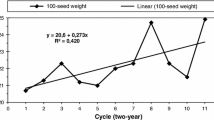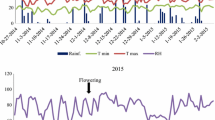Abstract
Consumers hold landraces in high esteem and often consider that breeding programs lead to a loss of sensory quality, although consumers’ opinions have not been scientifically confirmed. As a model case of study we recorded seed sensory traits in six inbred common bean lines classified in the market class Fabada obtained by backcrossing and/or pedigree selection (to change the plant architecture and increase resistances) and then cultivated in two environments in two consecutive years. A sensory panel noted differences among all the inbreds, but only the introduction of the gene fin (determinate growth habit) seemed to be associated to a loss of quality (rougher seed coat and lower percentage of whole beans after cooking). As theoretically expected, changes in sensory traits were smaller in inbreds obtained through simple backcrossing than in those obtained through pedigree selection after inbred crossing. Large differences in sensory traits due to environmental factors were also recorded (similar to the genetic effects in magnitude), especially soil type and rainfall around flowering. These results make it highly recommendable to evaluate sensory attributes in the course of breeding programs to ensure that the sensory quality is not lost. Given the importance of the environmental component in the phenotypic variation of the sensory traits studied, crop location and management also appear as key factors for the obtainment of optimum products.



Similar content being viewed by others
References
Aylesworth JW, Tu JC, Buzzell RI (1983) Sanilac BC6-are white bean breeding line. Hortscience 18(1):115
Bhattacharjee P, Singhal RS, Kulkarni PR (2002) Basmati rice: a review. Int J Food Sci Technol 37(1):1–12
Casanas F, Pujola M, del Castillo RR, Almirall A, Sanchez E, Nuez F (2006) Variability in some texture characteristics and chemical composition of common beans (Phaseolus vulgaris L). J Sci Food Agric 86(14):2445–2449. doi:10.1002/jsfa.2638
Chaib J, Lecomte L, Buret M, Causse M (2006) Stability over genetic backgrounds, generations and years of quantitative trait locus (QTLs) for organoleptic quality in tomato. Theor Appl Genet 112(5):934–944. doi:10.1007/s00122-005-0197-7
Del Romero Castillo RR, Valero J, Casanas F, Costell E (2008) Training, validation and maintenance of a panel to evaluate the texture of dry beans (Phaseolus vulgaris L.). J Sens Stud 23(3):303–319
Fehr W (1987) Breeding methods for cultivar. Soybeans: improvement, production and uses, 2a edn. American Society of Agronomy, Madison
Ferreira J, Campa A, Pérez-Vega E (2007) Nuevas variedades de judía tipo Faba Granja desarrolladas en el SERIDA: resultados de las evaluaciones morfológicas, agronómicas y de calidad. SERIDA KRK Ediciones
Florez A, Pujola M, Valero J, Centelles E, Almirall A, Casanas F (2009) Genetic and environmental effects on chemical composition related to sensory traits in common beans (Phaseolus vulgaris L.). Food Chem 113(4):950–956. doi:10.1016/j.foodchem.2008.08.036
Galiotou-Panayotou M, Kyriakidis NB, Margaris I (2008) Phytase-phytate-pectin hypothesis and quality of legumes cooked in calcium solutions. J Sci Food Agric 88(2):355–361. doi:10.1002/jsfa.2973
Guerrero L, Guàrdia MD, Xicola J, Verbeke W, Vanhonacker F, Zakowska-Biemans S, Sajdakowska M, Sulmont-Rossé C, Issanchou S, Contel M, Scalvedi ML, Granli BS (2009) Consumer-driven definition of traditional food products and innovation in traditional foods. A qualitative cross-cultural study. Appetite 52(2):345–354
Hoberg E, Ulrich D, Gottwald J, Rosen A (2003) Environmental influences on the sensory quality of Asparagus officinalis L. In: Tijskens LMM, Vollebregt HM (eds) Proceedings of the international conference on quality in chains, vols 1 and 2 - an integrated view on fruit and vegetable quality. Acta horticulturae. International Society Horticultural Science, Leuven, pp 395–401
ISO International Standard 8589 (2007) Sensory analysis–General guidance for the design of test rooms. International Organization for Standardization, Geneva
Jin L, Lu Y, Shao Y, Zhang G, Xiao P, Shen S, Corke H, Bao J (2009) Molecular marker assisted selection for improvement of the eating, cooking and sensory quality of rice (Oryza sativa L.). J Cereal Sci 51(1):159–164
Kigel J (1999) Culinary and nutritional quality of Phaseolus vulgaris seeds as affected by environmental factors. Biotechnol Agron Soc Environ 3(4):205–209
Labuschagne IF, Schmidt K, Booyse M (2004) Fruit quality assessment in apple breeding progenies. In: Laurens F, Evans K (eds) Proceedings of the XIth Eucarpia symposium on fruit breeding and genetics, vols 1 and 2. Acta Horticulturae. International Society Horticultural Science, Leuven, pp 321–325
Lecomte L, Gautier A, Luciani A, Duffe P, Hospital F, Buret M, Causse M (2004) Recent advances in molecular breeding: the example of tomato breeding for flavor traits. In: McCreight JD, Ryder EJ (eds) Advances in vegetable breeding. Acta horticulturae. International Society Horticultural Science, Leuven, pp 231–242
Marsh HD, Paterson T, Seal AG, McNeilage MA (2003) Heritability estimates in kiwifruit. In: Janick J (ed) Genetics and breeding of tree fruits and nuts. Acta horticulturae. International Society Horticultural Science, Leuven, p 221
Mendez-Vigo B, Rodriguez-Suarez C, Paneda A, Ferreira JJ, Giraldez R (2005) Molecular markers and allelic relationships of anthracnose resistance gene cluster B4 in common bean. Euphytica 141(3):237–245. doi:10.1007/s10681-005-7075-x
Menezes JR, Dianese JC (1988) Race characterization of Brazilian isolates of colletotrichum-lindemuthianum and detection of resistance to anthracnose in Phaseolus-vulgaris. Phytopathology 78(6):650–655
Oraguzie NC, Whitworth C, Fraser J, Alspach PA, Morgan CGT (2003) First generation of recurrent selection in apple: estimation of genetic parameters. In: Janick J (ed) Genetics and breeding of tree fruits and nuts. Acta horticulturae. International Society Horticultural Science, Leuven, pp 213–220
Perez-Vega E, Paneda A, Rodriguez-Suarez C, Campa A, Giraldez R, Ferreira JJ (2010) Mapping of QTLs for morpho-agronomic and seed quality traits in a RIL population of common bean (Phaseolus vulgaris L.). Theor Appl Genet 120((7):1367–1380. doi:10.1007/s00122-010-1261-5
Santalla M dRA, Voysest O (2001) European bean market classes. In: Amurrio M, de Ron AM, and Santalla M , (eds), Catalogue of bean genetic resources Fundación Pedro Barrié de la Maza/PHASELIEU-FAIR-PL97-3463-MBG-CSIC:79–94
SAS Institute Inc. (1999) SAS/STAT® User’s Guide, Version 8. SAS Institute Inc. Cary
Schonhof I, Krumbein A, Bruckner B (2004) Genotypic effects on glucosinolates and sensory properties of broccoli and cauliflower. Nahr-Food 48(1):25–33. doi:10.1002/food.200300329
Singh S (1982) A key for identification of different growth habits of Phaseolus vulgaris L. Annu Rep Bean Improv Coop 25:92–94
Van ruth SM, Roozen JP, Posthumus MA (1995) Instrumental and sensory evaluation of the flavor of dried french beans (Phaseolus-vulgaris) influenced by storage-conditions. J Sci Food Agric 69(3):393–401
Voysest O (2000) Mejoramiento genético del frijol (Phaseolus vulgaris L.) : Legado de variedades de América Latina 1930-1999. Centro Internacional de Agricultura Tropical (CIAT), Cali
Acknowledgments
This work was supported by grants RTA2005-00115-C02-01 and AGL2007-66563-C02-02 from the Ministry of Science and Innovation, Spain. E. Pérez-Vega received a fellowship salary from INIA (Madrid, Spain).
Author information
Authors and Affiliations
Corresponding author
Rights and permissions
About this article
Cite this article
Ferreira, J.J., del Castillo, R.R., Perez-Vega, E. et al. Sensory changes related to breeding for plant architecture and resistance to viruses and anthracnose in bean market class Fabada (Phaseolus vulgaris L.). Euphytica 186, 687–696 (2012). https://doi.org/10.1007/s10681-011-0540-9
Received:
Accepted:
Published:
Issue Date:
DOI: https://doi.org/10.1007/s10681-011-0540-9




